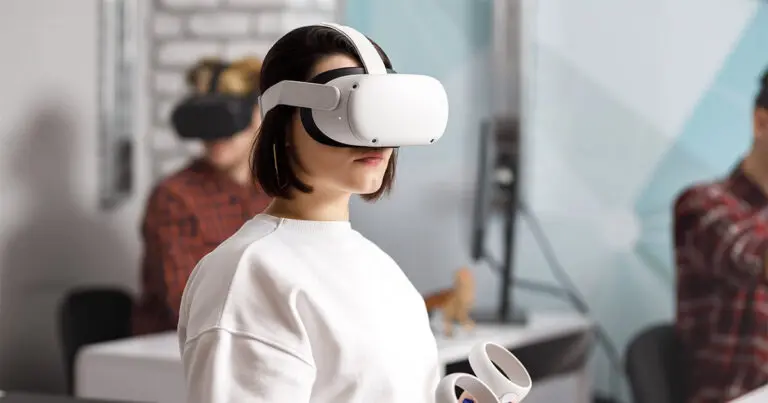The Role of Virtual Reality in Employee Training and Development

Imagine stepping into a virtual environment where you can practice complex procedures or role-play customer interactions without any real-world consequences.
This is the power of virtual reality training, where employees experience hands-on, immersive learning that traditional methods can’t match.
In today’s rapidly evolving workplace, employee training and development are crucial for maintaining a competitive edge.
As technology advances, virtual reality (VR) is emerging as a powerful tool in revolutionizing how companies deliver corporate training.
How has employee training changed over the years?
Employee training has changed over the years from traditional training methods to technological advancements and VR training.
Traditional training methods
For decades, traditional training methods like classroom training, seminars, and on-the-job learning were the standard.
Classroom learners would sit through lectures, work through exercises, and then attempt to apply what they learned in real-world situations.
However, while these traditional methods offered some value, they lacked the hands-on experience needed for skill retention and practical application.
Technological advancements
The introduction of training platforms and e-learning marked the first significant shift in employee development.
These innovations allowed remote workers to access training content from anywhere, expanding access to effective training solutions.
Today, we are witnessing the next frontier in immersive learning with the rise of virtual reality (VR), a training tool that goes beyond standard digital methods to provide a fully immersive training experience.
Virtual reality (VR) training
Unlike traditional e-learning, virtual reality training places employees in virtual simulations where they can interact with realistic environments and practice skills in a safe environment.
Whether it’s a medical professional perfecting a surgical technique or customer service representatives honing their communication skills, VR offers immersive experiences that create lasting learning outcomes.
How virtual reality is leveraged in training and development
Virtual reality is leveraged in training and development through VR tech, industries that use VR, and the outcomes of VR in employee training.
VR tech for employee training
At the heart of virtual reality training are VR headsets, motion sensors, and specialized software that create a realistic environment for learners.
Employees can enter virtual simulations that replicate real-world situations, from safety training for high-risk jobs to soft skills training for developing interpersonal skills.
The immersive nature of VR helps close skills gaps by offering detailed feedback and real-time feedback during the learning process.
Industries that use VR employee training
Several industries are already harnessing the potential of VR for training purposes.
In the healthcare sector, medical professionals use VR for medical training, allowing them to practice complex procedures in a risk-free environment.
Similarly, industries like manufacturing and retail have adopted VR for safety training and customer service training, where real-world scenarios can be simulated safely.
Even in military training, VR is used to prepare soldiers for dangerous environments and difficult circumstances.
Outcomes of VR in employee training
The benefits of VR in training are clear. Employees engage in realistic simulations where they can practice decision-making skills and other essential skills in a controlled environment.
This leads to better training outcomes, including higher retention rates, improved training effectiveness, and a deeper understanding of the material due to experiential learning.
VR’s ability to mimic real-world risks allows for hands-on experience that enhances employee confidence and competence.
Real-world examples of VR in employee training
Walmart VR employee training
Walmart uses VR to train employees in customer service, compliance, and how to handle difficult scenarios, such as Black Friday shopping. Their VR program allows employees to experience real-world situations without the risks of live training.
Verizon VR employee training
Verizon uses VR to train employees in handling dangerous situations, such as armed robberies, by simulating these events in a controlled, virtual environment.
UPS VR employee training
The shipping company uses VR to train drivers on safe driving practices. Trainees are placed in virtual delivery environments to learn how to detect and avoid hazards.
Hilton Hotels VR employee training
Hilton has implemented VR training to give team members a feel for guest interactions, property tours, and various hotel roles in a more immersive, hands-on way.
Ford VR employee training
The automaker uses VR to simulate vehicle designs and collaborative engineering work, helping to train staff on design evaluation, ergonomics, and assembly techniques.
DHL VR employee training
DHL uses VR to train employees in areas like warehouse operations and logistics, simulating real-world tasks and improving efficiency and safety without disrupting day-to-day operations.
Benefits of VR in employee training
Benefits of VR in employee training include increased engagement, practical skill development, improved retention rates, and cost-effective solutions.
Increased engagement
One of the standout advantages of VR is how it boosts engagement.
Employees remain immersed in real-world situations, staying focused as they interact with virtual environments.
This immersive learning platform increases motivation by placing learners in real-world scenarios where they must apply skills, rather than passively absorbing information.
Practical skill development
VR allows employees to develop practical skills in a safe environment where mistakes don’t have real-world consequences.
Whether it’s navigating an emergency in the workplace or operating heavy machinery, VR offers a space where instant feedback is provided, allowing learners to refine their skills in real time.
Improved retention rates
Studies show that immersive learning experiences like VR lead to significantly higher retention rates compared to classroom training or online courses.
The emotional impact of fully immersive experiences helps embed information more deeply, resulting in better knowledge retention.
Cost-effective solutions
While the initial investment in VR might seem high, the long-term savings make it a cost-effective training solution.
Companies can reduce the need for physical spaces, instructors, and materials. Additionally, businesses save on travel expenses, especially when conducting training sessions for remote workers.
Challenges and considerations of VR in employee training
Challenges and considerations of VR in employee training include investment in VR technology, potential resistance to adopting new tech, and ensuring updated and relevant content.
Investment in VR technology and content creation
Implementing VR for training requires an upfront investment in immersive learning platforms, including hardware and software.
Developing training content that accurately represents the workplace can also require substantial resources.
Potential resistance to adopting new technologies
Some employees and managers may be resistant to adopting VR, especially those who are comfortable with traditional methods.
Overcoming this hesitation requires demonstrating the training effectiveness and value of VR as part of a broader training program.
Ensuring updated and relevant content
For VR training to be successful, companies must ensure that their training scenarios remain current.
As industries evolve, training content needs to reflect new procedures, technologies, and customer conversations to remain relevant.
Future trends in VR for employee development
Future trends in VR for employee development include several predictions for VR in employee training, gamification, and the potential for VR in team-building.
Predictions for VR in employee training
Looking forward, the integration of artificial intelligence (AI) into VR could create more personalized learning experiences.
AI can analyze an employee’s performance during a training session and adjust the training process in real-time, optimizing the learning outcomes.
Gamification in VR training
Gamification is another trend that’s expected to grow in VR.
By adding game-like elements to VR training experiences, companies can drive employee engagement and improve training effectiveness.
Gamified training keeps learners motivated while also making the learning process more enjoyable.
Potential for VR in team-building
Beyond technical skills, VR offers opportunities for soft skills training and team-building activities.
Employees can practice communication skills and other interpersonal skills through simulated environments, enhancing both individual and group performance.
Roles or contractors to hire to implement VR for employee training
To successfully integrate VR into employee training, businesses will need specialized roles such as:
VR developers
VR developers are responsible for creating immersive experiences through the use of advanced technologies.
They write code, design interfaces, and select the right hardware for VR training programs.
Instructional designers
Instructional designers play a crucial role in developing training content that accurately represents the workplace.
They work closely with subject matter experts to create interactive and engaging VR scenarios that align with specific learning objectives.
Project managers
Project managers oversee the entire process of implementing VR into employee training programs.
Their responsibilities include coordinating with different teams, setting timelines, and ensuring that all elements come together to deliver a successful VR training experience.
Leveraging VR in employee training
In conclusion, virtual reality is transforming the landscape of corporate training by offering immersive learning experiences that go far beyond what traditional training methods can achieve.
By adopting VR, businesses can improve employee engagement, retention, and skill development while benefiting from long-term cost savings.
As companies look to the Future Workplace, integrating VR into their training strategy will provide a significant competitive advantage.
Now is the time for businesses to explore how virtual reality training can help close skills gaps and prepare their workforce for the challenges of tomorrow.
Looking to hire top-tier Tech, Digital Marketing, or Creative Talent? We can help.
Every year, Mondo helps to fill over 2,000 open positions nationwide.
More Reading…
- Building a Resilient Organization: Strategies for Long-Term Success
- Why Workers Are Shifting Toward Gig Work — And How Staffing Agencies Can Help
- Is AI to Blame for Job Mismatches? AI-Crafted Resumes & the Interview Dilemma
- Employee Wellbeing Programs: Best Practices
- How to Create a Talent Pipeline in a Competitive Market
- How AI is Transforming the Healthcare Industry and What the Future Holds
- The Growing Importance of Embracing Neurodiversity in the Workplace
- 8 Traits of “Good Bosses” People Want to Work For
- Preparing for Gen Alpha: the Next Generation of Workers
- Why Is Diversity in Leadership Important? Top Benefits & Strategies
- CrowdStrike Outage Highlights Importance of Incident Response Planning



